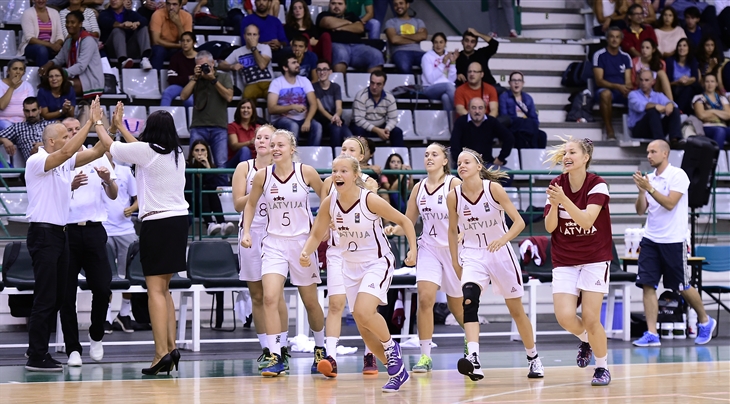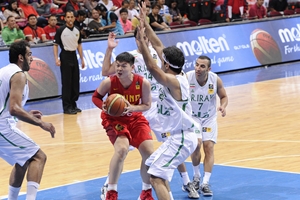
Fresh feel for U17 Worlds, but no regional changes
NEWCASTLE (Paul Nilsen's Women's Basketball Worldwide) - The decision to jointly hold the men's and women's U17 World Championships next year in Spain isn't the only thing to inject a fresh feel into the to the tournament.
The 2015 FIBA U17 Women's World Championship already has some really different and exciting elements lying in wait - all being thrown up as U16 qualifying tournaments conclude around the world.
For example, seeing Latvia and Portugal make their debuts is going to be terrific since having new teams appear will, in itself, be particularly stimulating.
Amongst all the adulation in my last column about Portugal's advancement, the historic achievement of Latvia was perhaps unfairly overshadowed.
History continues to flow #FIBAU16Europe as @basketbols jump for joy after stunning win v Hungary.See you at #FIBAu17 pic.twitter.com/RLcaEJPfnz
— Paul Nilsen (@basketmedia365) August 22, 2015
However I am happy to give due props to Liga Alilujeva and her players for a magnificent accomplishment. It was also great to see an aspiring female coach under the age of 30 at the helm of a real success story.
There should be a potential transformation for other nations such as Italy, who were left stung in Czech Republic at the last edition when they were surprisingly beaten by Mali in a landmark result for their African opponents.
This time around, Italy could seriously threaten the podium after impressing at the U16 European Championship Women in Matosinhos where they finished third but had the best record of any team with eight wins and only a solitary loss [in the Semi Finals].
Italy have serious size and it bodes well for the future of the senior team too, since they have struggled to find enough depth in their frontcourt over the years. Lorela Cubaj, Sara Madera and Valeria Trucco all have a bonafide shot at making it in the future.
Congrats @Italbasket on winning bronze. Brilliantly coached..Great prospects...outclassed Spain 70-54 #FIBAU16Europe pic.twitter.com/MwnlIaiEES
— Paul Nilsen (@basketmedia365) August 23, 2015
I am also hoping that experienced head coach Giovanni Lucchesi continues to hold the reins, since he did a fine job.
One of the other interesting dynamics is that with Portugal and Latvia crashing the party at the expense of Russia and Hungary [who fluffed their lines spectacularly and missed out], has re-ignited the debate in some quarters about how many qualifying spots should go to Europe.
It is probably an accurate assumption that both Russia and Hungary would be equipped to beat most teams from other continents [outside of the USA and Australia] in Spain next year. Therefore it may seem logical to increase the number of berths available.
But maybe having too many European teams would dilute the global feel and five is enough for me, with six if the host is from Europe - as will be the case next year.
I also think that Russia and particularly Hungary must actually suffer the pain of missing out. And believe me, it hurts. I have never seen a team react so painfully to losing as Russia after their gut-wrenching 17-point turnaround, buzzer-beating defeat to France.
Equally, I would also go so far as to say that Hungary are the best team I have ever seen miss out on a spot at any world event. They had incredibly talented players but the wheels came crashing off and questions will and should be asked about the coaching. Their team in Matosinhos should have grabbed a medal and at the absolute minimum - a spot for Spain.
Ensuring teams in Europe are disappointed is an ingredient which needs to remain in situ. Having too many tickets available would mean simply reaching the top eight at a European Championship would be mission accomplished if they were to get a greater share.
Which now brings me to the Americas. I mentioned after the FIBA U19 Women's World Championship that it felt like four spots was one too many for them. It still feels that way because of a lack of depth, although people are now convincing me that after Brazil shocked the USA by beating them at the FIBA Americas U16 Women's Championship [which was eventually won by Canada], that things could be changing.
Whether that is down to the dynamic of USA having not chosen the best players available and Brazil having had a standout player and potential superstar of the future in Izabela Leite, remains to be seen.
If Americas do want to maintain their allocation, then the likes of Brazil and Argentina need to keep producing and Mexico must keep pushing in their advancement.
At the moment, taking away a slot from Americas at U17 level leaves a dilemma of where it would go to - because outside of Europe, I can't see anywhere more appropriate just yet. And, as I have explained, Europe is probably fully subscribed.
Perhaps the coming together of Asia and Oceania in coming years will provide the impetus for a re-think.
Paul Nilsen
FIBA
FIBA's columnists write on a wide range of topics relating to basketball that are of interest to them. The opinions they express are their own and in no way reflect those of FIBA.
FIBA takes no responsibility and gives no guarantees, warranties or representations, implied or otherwise, for the content or accuracy of the content and opinion expressed in the above article.



























